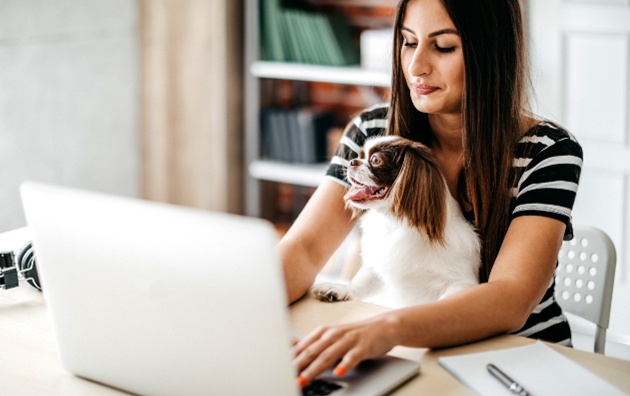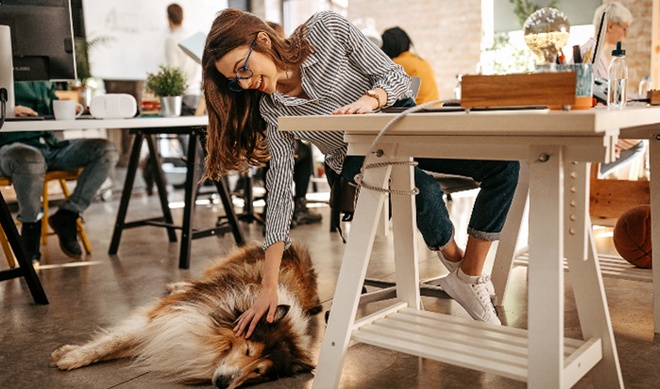
Reading time : 4 min
Creative agencies aren't the only ones to have gone canine. More and more companies are recognizing the positive effect that having a dog in the office can have on employees, and allowing them to take their dog with them. 62.5% of the 902 customers surveyed in France take their dog to work, including more than half of employees (52.98%) and almost all self-employed people (90.11%).
This impressive figure can also be explained by changes in the working environment since the pandemic. The number of dog purchases increased during Covid, as it was easier to look after one's four-legged companion when working from home. However, since the end of the pandemic, more and more companies are calling their employees back into the office - and with them their new four-legged companions. After all, where are they supposed to stay when their masters are in the office all day? In the battle for talent, companies today are more receptive to special requests than in the past. That's why 52.7% of people who bring their dogs to the office today bring them along every day. Around a fifth of those surveyed bring their dog to the office two or three times a week.
Interesting fact: the majority of office dogs (48.35%) spend a normal working day of seven to eight hours in the office. This may seem like a long time at first glance.
"But if the dog has a quiet place to sleep, feels comfortable in the office and gets regular breaks in the fresh air, which both owner and dog enjoy equally, the dog can be much less stressed than if he has to wait alone at home," explains Sylvia Masson, veterinary surgeon and Weenect expert.
"But the dog needs to get used to it slowly. Start with half a day to familiarize the dog with the environment, people and habits, then gradually extend this period," she advises. "However, frequent licking, constant yawning, agitation and, in the worst cases, barking and growling are warning signs. In this case, the dog is in over his head and the stay should be terminated as soon as possible".
"There is no general breed recommendation for the office dog as such. It's more important that the dog has a balanced character and is friendly to people," explains Sylvia Masson.
Some companies already make this a requirement, although only 13.65% of those surveyed confirmed the existence of rules concerning the introduction of a dog into the office. However, these rules include, for example, vaccination, deworming and leash requirements, as well as the obligation to place the dog behind the desk. In some cases, dogs are only allowed on certain floors or in certain offices.
"At the end of the day, it's all about ensuring that work remains productive and harmonious for all colleagues. Taking account of people who are allergic to pet hair or who have a fear of animals is a fundamental requirement."
"Employees often go up to the dog unasked, wanting to pet it or encourage it to play, which can be counterproductive when the dog has just calmed down. The dog's resting area must be off-limits so that the animal has a safe space in which to relax. And only a relaxed dog can create a relaxed atmosphere in the office," explains Sylvia Masson.
At Weenect, the GPS tracking company for dogs and cats, visits from dogs are a matter of course. But there are no rules without rules, especially when two dogs don't get along. Bénédicte de Villemeur-Vieille, co-founder and head of sales, and Eleonora, junior in customer service and event coordinator, must have realized this. Their two male dogs, Sid, a 9-year-old mixed-breed, and Yako, a 6-year-old Shiba Inu, are both very quiet office companions as long as they're alone on site.
"Sid likes to sleep under the desk, at our feet, while Yako sometimes sits cheekily in front of the computer. Unfortunately, they can't stand each other, which has led to some aggressive incidents in the office in the meantime," explains Bénédicte de Villemeur Vieille. "Since then, we've set up a coordination system that involves bringing the dogs to the office on different days. However, if they're both there at the same time, they have to be kept in separate rooms. This means they are much less stressed, but they stay with their owners and the team can work in peace”.
"Si vous le pouvez, laissez d'abord les chiens faire connaissance à l'extérieur", conseille Sylvia Masson. Si les chiens apprennent à se connaître sur un terrain neutre et que la relation se stabilise au cours d'une promenade, ils devraient également s'accepter au bureau.
Click on the buttons below to save this press release as a PDF or return to the Pressroom.

